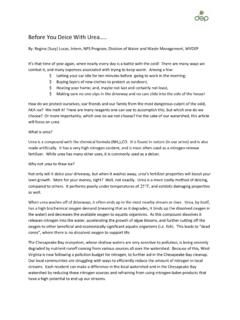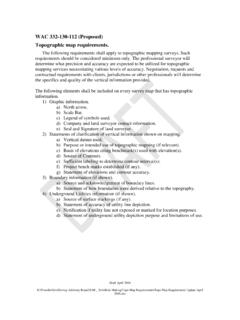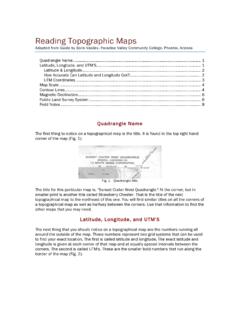Transcription of ws delin 2009 - WVCA - Home
1 IntroductionThis presentation explains and illustrates how to identify and draw watershed boundaries on a topographic map. The process is explained step by step in the next 16 pages. You should review this presentation until you have a good understanding of the process and then test your watershed delineation skills using the two additional topographic maps provided in pages 18 and 19 of this presentation. The correct delineations ( , the answers) for those two watersheds are provided on the last two pages of this presentation (pages 20 and 21). Note that the delineation of the second test watershed is more difficult than that of the first because the landscape is flatter, which makes the features shown by the topographic lines less Watershed BoundariesWhen we talk about the hydrologic cycle and the water budget, wetypically talk about these things in terms of watersheds.
2 So first you should know what a watershed topographically defined areas something like bowls. What we mean by that is that a watershed is separated from neighboring watersheds by high points on the landscape. You can think of a watershed as an area that, if precipitation falling into it was not evaporated back to the atmosphere and did not infiltrate into the soil, all of the water in the watershed would run downhill to the same stream. Delineating watershed boundaries. All watershed delineation means is that you re drawing lines on a map to identify a watershed s boundaries. These are typically drawn on topographic maps usinginformation from contour lines.
3 Contour lines are lines of equal elevation, so any point along a given contour line is the same elevation. To delineate a watershed s boundaries on a topographic map it s easiest if you first understand some things about these maps. Rather than taking a lot of time to explain that here, there are several good web sites that describe this. I recommend that you Google Read a topographic map to access some of those sites. But here are a few highlights of topographic maps, and a bit more information will be given later in the presentation. 1) The primary lines on a topographic map are called contour lines, and as stated before, they represent points of equal elevations.
4 Some of these lines are numbered, and those numbers are the elevations of those contour lines. In the , those elevations are typically given in feet above sea level. You can move across contour lines and know if the elevation is increasing or decreasing, by whether the number is increasing or decreasing. 2) Streams and rivers are shown by blue lines. Solid blue lines show perennial streams, and the dashed blue lines show what are estimated to be intermittent streams. 3) Contour lines point upstream (they form kind of what looks like a V) as they cross over a stream or river. 4) The closer the contour lines are together the steeper the terrain; the further apart they are the flatter the terrain.
5 So let s go through the steps to delineate a watershed s boundaries. First you need to identify the stream whose watershed boundaries you are going to identify. So let s say on this map we re going to delineate the watershed boundary for Billy Goat Run. So look for blue lines and find the one on this map with the name Billy Goat Run. It is in the lower left quadrant of this map. Next find the point on the stream that is the mouth of the watershed. The mouth of the watershed is the furthest downstream point of that stream, just where it meets another stream. By the way, the point where two streams or rivers meet is called their confluence.
6 Remember, where contour lines intersect streams, they point upstream (the point of the V points upstream). Consequently, the mouth of the watershed will be in the opposite direction of where the contour line V s point. So, the red circle marks the mouth of the watershed. Now you re ready to start tracing the watershed boundary, or the highestelevations that surround your watershed. You always start at the mouth of the watershed, which is also the lowest elevation of the watershed. In order to identify these high points, we have to know just a little bit more about topographic maps and how water will flow. One indicator of the high points or ridge lines is a bulge in a contour line that looks something like this: But how do you know exactly where on that bulge to draw the watershed boundary?
7 To figure that out, you need to understand how a contour line indicates the direction of water flow. Water will flow perpendicular to each contour line. For example, if the brown lines below are contour lines, the green arrows show the direction water would flow on the ground. So let s return to Billy Goat Run watershed, and try your hand at watershed delineation. xxxxGo to the first contour line on the right side of the circle marking the confluence. The watershed boundary on that line would be where the red X is located. Here s why. If you put the point further to the right on that contour line, a line perpendicular to the contour line would point to the right of the confluence (see the green arrow) and water flowing that direction wouldn t flow into Billy Goat Run.
8 Instead, it would flow into the larger stream that Billy Goat Run flows into. If you put your first point to the left of the X on that contour line, you can see the pink arrow indicates that water would move toward Bully Goat Run; which is what we want. HOWEVER, this point isn t the highest point, because flow at the red X would still be in the watershed and would flow approximately to the confluence. So this point is as far out on the contour line as you can go AND still have water flowing into the watershed. This X is the correct location for the start of the watershed boundary because the characteristics of that point make it the highestelevation on that contour line that would still allow water to drain into Billy Goat Run.
9 Continue using this kind of thought process to identify where the boundary makes most sense. Think about those bulges and the direction of flow at each contour line. Using this logic, the red X s on the map, indicate where the next several points on the contour lines should be located to identify the watershed boundary. xxxxxxxxxxxxxxxxxxxxxxxxxxxxxxxxxxxxxxxx xxxxAt this point on the map, we ve kind of lost the presence of obvious bulges. That s because the ground is actually becoming flatter and wider along the ridge. You can tell this because the contour lines now have things that look like circles, ovals, or oddly shaped circles (that is if you pick a point on the contour line, and follow it around, it simply returns back to that original point).
10 For simplicity, I ll refer to these as circles or circles within other circles identify high or low points on a topographic map. But since you ve been going along the high point of the ridge, you know that these circles are high points. The approximate center of the most-inner circle is assumed to approximate the highest point on the ground in that area. So using that information you can identify where the next several points should be located. xxxxxxxxxxxxxxxxxxxxxxxxxxxxxxxxxxxxxxxx xxxxxxxxxxxxxxxxxxxxxxxxxxxxxxxxxxxxxxxx xxxxxxxxxxxxxxxxxxxxxxxxxxxxxxxxNow you need to do some in-depth examination of the map to make sure you re still going to head in the correct direction.









